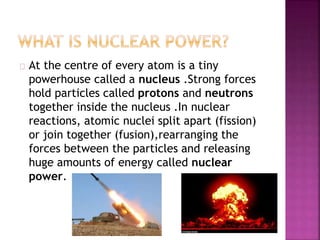Chemistry holidays homework nuclear weapons
- 1. At the centre of every atom is a tiny powerhouse called a nucleus .Strong forces hold particles called protons and neutrons together inside the nucleus .In nuclear reactions, atomic nuclei split apart (fission) or join together (fusion),rearranging the forces between the particles and releasing huge amounts of energy called nuclear power.
- 2. WHAT ARE NUCLEAR WEAPONS? ï‚¢ A Nuclear weapon is an explosive device that derives its destructive force from nuclear reactions ,either fission or a combination of fission and fusion. Both reactions release vast quantities of energy from relatively small amounts of matter. Two nuclear weapons have been used in the course of warfare, both times by the United States near the end of World War II.
- 4. TYPES OF NUCLEAR WEAPONS Fission Weapons Fusion Weapons
- 5. FISSION WEAPONS ï‚¢ When the nucleus of an atom splits apart it is called Nuclear Fission .Some heavy elements have unstable nuclei that can be made to split by bombarding them with neutrons. As the nuclei split, they release energy and more neutrons, which may strike other nuclei and start a chain reaction. In fission weapons, a mass of fissile material(enriched uranium or plutonium)is assembled into a supercritical mass.
- 6. FUSION WEAPONS ï‚¢ The joining together of two atomic nuclei is called Nuclear Fusion. Only light elements- those with few protons and neutrons in their nuclei-can take part in nuclear fusion reactions. Fusion reactions occur in the sun and other stars. Fusion weapons are generally referred to as Thermonuclear Weapons. Fusion reactions do not create fission products, and thus contribute far less to the creation of nuclear fallout.
- 7. OTHER TYPES ï‚¢ There are other types of nuclear weapons as well. For example, a boosted fission weapon is a fission bomb that increases its explosive yield through a small amount of fusion reactions, but it is not a fusion bomb. In the boosted bomb, the neutrons produced by the fusion reactions serve primarily to increase the efficiency of the fission bomb. So some weapons are designed for special purposes.
- 8. Nuclear Fallout Over 500 atmospheric nuclear weapons tests were conducted at various sites around the world from 1945 to 1980. Radioactive fallout from nuclear weapons testing was first drawn to public attention in 1954. As public awareness and concern mounted over the possible health hazards associated with exposure to the nuclear fallout, various studies were done to assess the extent of the hazard.
- 9. The waste from nuclear fuel is dangerously radioactive, so it must be dumped at sea or buried safely underground. Nuclear weapons tests and accidents at reactors can cause long-term health hazards by releasing radioactive material into the air.
- 10. I have done research on this topic from: Book encyclopedia Website Wikipedia Website rpfuller.com










